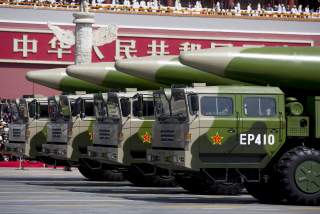Double Trouble: This Chinese Missile Can Kill Millions or Sink an Aircraft Carrier
The DF-26, which is now operational, has a range of 3,000-4,000 km and can carry a 1,200-1,800 kg nuclear or conventional warhead.
The DF-26, which is now operational, has a range of 3,000-4,000 km and can carry a 1,200-1,800 kg nuclear or conventional warhead. That means that China can strike directly at the U.S. territory of Guam in the event of a war—or it can be used to target ships at sea. As such, the massive 20,000 kg missile could not only target Guam but also America’s fleet of Nimitz and Ford-class nuclear-powered supercarriers.
The Chinese People’s Liberation Army Rocket Force (PLARF) commissioned the DF-26 intermediate-range ballistic missile (IRBM) into service earlier this year in April.
“The newly commissioned weaponry of the Rocket Force is Dongfeng-26 missile,” Senior Colonel Wu Qian, spokesman for China Ministry of National Defense, told reporters on April 26. “After the trial and operational test, this type of missiles are ready to be equipped to the full establishment of unit and have since then been officially commissioned to the Rocket Force.”
(This first appeared in June.)
Wu broke down the four key features of the DF-26 missile and what it means for China’s capabilities. “As a new generation of medium-and-long range missile, DF-26 has the following four features,” Wu said. “First, it is researched, developed and manufactured by China independently and we have complete property right over it. Second, it can carry both conventional and nuclear warheads, capable of both rapid nuclear counter-strikes and conventional medium-and-long range precision strikes. Third, it is capable of launching precision strikes at both critical target on land and medium- and large-sized vessels at sea. Fourth, several new technologies have been applied to the missile, which helps increase the missile’s utilization and improve its integration and informationization.”
Wu noted, however, that Beijing—unlike the United States or Russia—continues maintain a strict “no first use” of nuclear weapon policy despite the fielding of the new weapon. “It should be stressed that there is no change in China’s self-defense nuclear strategy and ‘No First Use’ of nuclear weapons policy,” Wu said.
The DF-26, which is now operational, has a range of 3,000-4,000 km and can carry a 1,200-1,800 kg nuclear or conventional warhead. That means that China can strike directly at the U.S. territory of Guam in the event of a war—or it can be used to target ships at sea. As such, the massive 20,000 kg missile could not only target Guam but also America’s fleet of Nimitz and Ford-class nuclear-powered supercarriers.
As Wu stated, because the DF-26 is supposed to be capable of “both rapid nuclear counter-strikes and conventional medium-and-long range precision strikes” while also being designed to hit maritime targets, there must be several versions. And there are at least two: DF-26A and DF-26B—of the missile with different warheads and guidance packages. One version is probably designed to hit fixed ground targets and is likely fitted with a dual nuclear/conventional warhead, which could have a circular error of probability of 150-450 meters.
However, the anti-ship ballistic missile variant of the DF-26 weapon that is designed to target ground and maritime targets, the missile must be extremely accurate. Thus, the circular error of probability is likely very small—possibly as little as 10m according to some estimates. But exactly how the weapon is targeted and guided is not clear. In any case, the kill chain for the missile would be extremely long and complicated—and thus far there does not appear to have been a publicly acknowledged test of the weapon against a target at sea.
Recommended: Why an F-22 Raptor Would Crush an F-35 in a 'Dogfight'
Recommended: Air War: Stealth F-22 Raptor vs. F-14 Tomcat (That Iran Still Flies)
Recommended: A New Report Reveals Why There Won't Be Any 'New' F-22 Raptors
There has been some speculation that a May 2017 missile test in waters near the Korean peninsula was a DF-26, however, there is no official acknowledgement from the People’s Liberation Army. “The People’s Liberation Army Rocket Force conducted a test of a new type of missile somewhere in Bohai [Sea] in recent days, and achieved desired results,” the Chinese Ministry of National Defense said on May 9, 2017. However, Beijing offered no details of about the weapon that was being tested.
“The missile might be launched from the northwest to the east by the Rocket Force, with a range of 2,000km or above. It was likely the advanced intermediate-range DF-26B, a modified version of the DF-26,” Hong Kong-based military analyst Liang Guoliang told the South China Morning Post at the time. “Given the landing area, the test is obviously aimed at THAAD in South Korea.”
Liang, however, was speculating—as were the other analysts cited in the report. But it is certainly possible that Beijing did test the DF-26, but there is no hard evidence.


